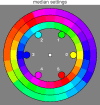Hues of Color Afterimages
- PMID: 32180934
- PMCID: PMC7058369
- DOI: 10.1177/2041669520903553
Hues of Color Afterimages
Abstract
We studied the relationship between color afterimages and complementary colors. The hues of afterimages of 24 inducer hues, uniformly distributed over the rgb color circle, were measured by an iterative method of adjustment. The judgment of equality of hue of the afterimage and a synthesized patch was effectively judged at the moment immediately after the switch-off of the inducer, when the synthesized patch went through any number of iterative adjustments. The two patches-both phenomenally present, but only one optically presented-appeared to the left and right of a fixation mark that was fixated throughout the whole procedure. Thus, both patches were present in eccentric vision. The hues of afterimages were found to be quite different from the hue of the complementary of the inducer. Almost one half of the color circle (orange to chartreuse) leads to afterimage hues in a narrow region of purples. This implies that color circles based on diametrically opposed inducer-afterimage hues are necessarily inconsistent. Yet, perhaps surprisingly, the relation between primary and afterimage hues is still approximately an involution (they are reciprocally related).
Keywords: RGB colors; afterimage; color; complementary colors; gamma correction; supplementary colors.
© The Author(s) 2020.
Figures











References
-
- Albertazzi L., Koenderink J., van Doorn A. (2015). Chromatic dimensions earthy, watery, airy, and fiery. Perception, 44, 1153–1178. - PubMed
-
- Aubert H. (1865). Physiologie der netzhaut [Physiology of the retina] (p. 365). Breslau, Germany: Verlag von E.Morgenstern (fr. Aug. Schulz & Co.).
-
- Bagley M.-O., Maxfield M. S. (1986). Afterimage color perception for designers. Perceptual and Motor Skills, 63, 995–1007. - PubMed
-
- Bouma P. J. (1948). Physical aspects of colour: An introduction to the scientific study of colour stimuli and colour sensations. Eindhoven, the Netherlands: Philips Technical Library, Philips Gloeilampenfabrieken (Philips Industries) Technical and Scientific Literature Dept.
LinkOut - more resources
Full Text Sources

